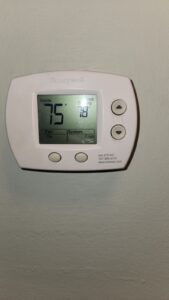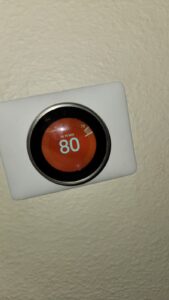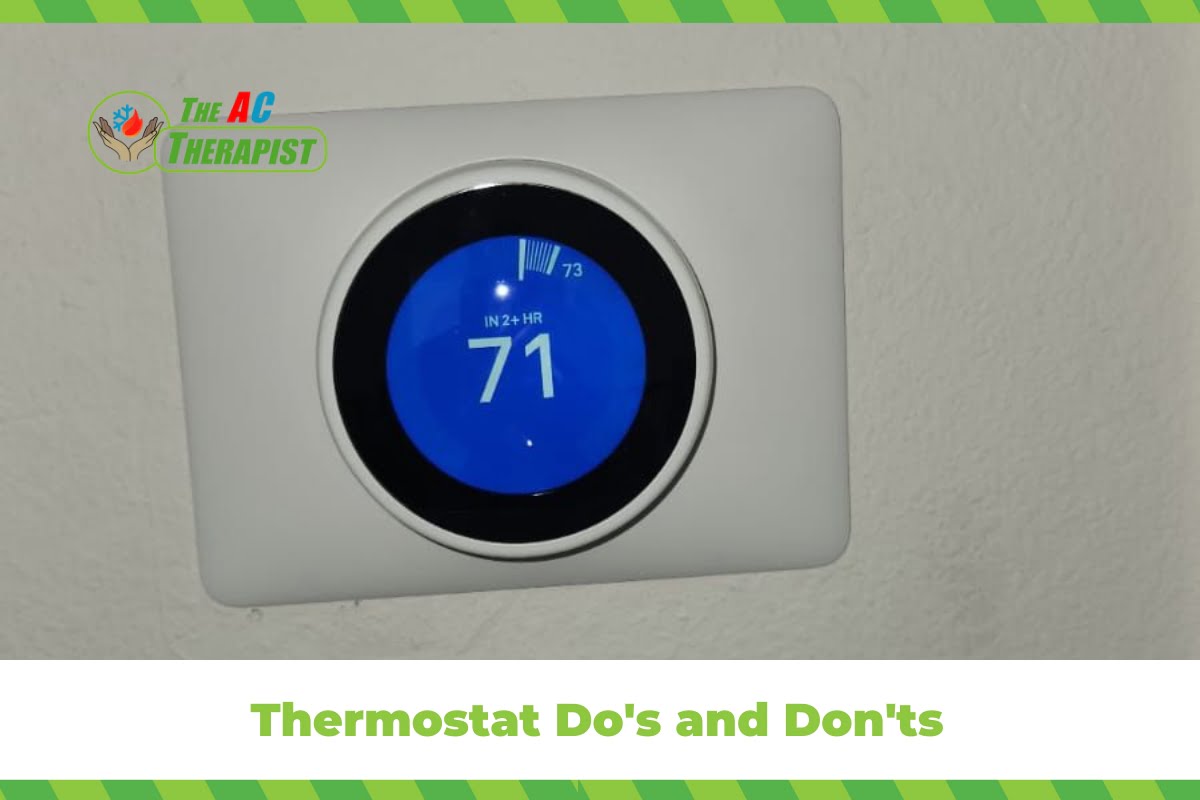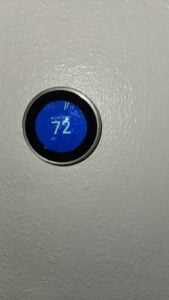Thermostat Do’s and Don’ts
A thermostat can be a powerful tool when it comes to maintaining a comfortable living environment. Yet, many people don’t fully understand how to maximize its benefits. Whether you have a traditional thermostat or a smart, Wi-Fi-connected device, this guide will take you through the essential do’s and don’ts to help you optimize efficiency, reduce energy costs, and maintain the perfect temperature year-round.
DO: Understand Your Thermostat Type
Understanding your thermostat type is crucial for maximizing its efficiency and ensuring you get the most out of its features. Different types of thermostats offer varying levels of control and functionality. Here’s a brief overview:
- Mechanical Thermostats: These are the traditional types that use bimetallic strips or gas-filled bellows to control temperature. They’re relatively straightforward to use but lack the advanced features found in modern thermostats.
- Programmable Thermostats: These allow you to set temperature schedules for different times of the day or different days of the week. This means you can set it to automatically lower the heat when you’re not home, and warm up just before you return, for example.
- Smart Thermostats: These offer the most features, including remote control through a smartphone app, learning algorithms that adapt to your schedule, and even integration with other smart home devices. They provide the most control but also tend to be the most expensive.
Understanding your thermostat type helps you to make the most out of its features, be it setting schedules, analyzing energy usage, or integrating it into a smart home ecosystem.

DON’T: Neglect Regular Maintenance
Neglecting regular maintenance of your thermostat can lead to inefficiencies in your heating and cooling system, ultimately costing you more money and possibly compromising the comfort of your home. Here are some reasons why regular maintenance is essential:
- Accurate Readings: Dust and debris can accumulate on the thermostat, causing it to give inaccurate temperature readings. This can result in your HVAC system running longer than necessary, increasing your energy costs.
- Longevity: Like any other piece of equipment, thermostats can wear out over time. Regular check-ups can identify issues before they become major problems, extending the lifespan of the device.
- Software Updates: For smart thermostats, regular maintenance includes updating the software to ensure you have the latest features and security patches.
- Battery Life: Some thermostats run on batteries, and neglecting to change these can result in complete system failure. Always make sure that your thermostat’s batteries are in good shape, especially before seasons of heavy usage.
- Calibration: Over time, thermostats can become miscalibrated. Regular maintenance checks can include recalibration, ensuring that the temperature you set is the temperature you get.
- Cost Savings: Inefficient heating and cooling due to a poorly maintained thermostat can drive up energy costs. Regular maintenance helps keep those costs down by ensuring that your system is functioning optimally.
Regular maintenance of your thermostat is vital for ensuring it operates efficiently, maintains accurate temperature control, and offers long-lasting service.

DO: Set a Schedule (Programmable and Smart Thermostats)
Setting a schedule on your programmable or smart thermostat is one of the most effective ways to optimize energy use while maintaining a comfortable living environment. Here’s why and how you should do it:
Why Set a Schedule:
- Energy Savings: A well-planned schedule can significantly reduce your energy consumption, translating into lower utility bills.
- Consistent Comfort: By setting a schedule, you ensure that your home is at a comfortable temperature when you’re there, without wasting energy when you’re not.
- Convenience: Once set, the schedule runs automatically, so you don’t have to remember to adjust the temperature multiple times a day.
- Adaptability: Smart thermostats can even adapt your schedule based on learned behaviors and preferences over time.
How to Set a Schedule:
For Programmable Thermostats:
- Review Manual: Before setting a schedule, consult the user manual for specific instructions related to your model.
- Plan Your Week: Identify when you’re usually home, away, or asleep. Plan temperature settings around your routines.
- Input Settings: Use the device interface to input your planned temperature settings for different times and days.
- Test: After setting the schedule, monitor it for a few days to make sure it’s working as expected, and make adjustments as necessary.
For Smart Thermostats:
- Use the App: Most smart thermostats come with an associated app. Use this to set up your schedule easily.
- Learning Features: Some smart thermostats can learn from your behavior. For the first week, manually adjust the temperature to your comfort level, and the thermostat will adapt.
- Geo-fencing: Some models can detect when you’re nearing home and adjust the temperature accordingly.
- Integration: If you have other smart home devices, consider integrating them with your thermostat for more advanced scheduling options, like lowering the temperature when your smart door lock is activated.
By setting a schedule on your programmable or smart thermostat, you can maximize energy efficiency, reduce costs, and enjoy a consistently comfortable home.
Maximize the capabilities of your programmable or smart thermostat by setting a daily or weekly schedule that aligns with your routine.
Example Schedule:
- 6:00 AM to 8:00 AM: Set the temperature to 70°F while you get ready for work.
- 8:00 AM to 6:00 PM: Lower to 65°F if no one is home.
- 6:00 PM to 11:00 PM: Back to 70°F when you’re back home and awake.
- 11:00 PM to 6:00 AM: Lower it to 68°F when you’re sleeping.
DON’T: Frequently Change Settings on Mechanical Thermostats
Frequently changing the settings on a mechanical thermostat can lead to several issues that impact both the efficiency and effectiveness of your heating and cooling system. Here’s why you should avoid doing so:
- Inefficiency: Mechanical thermostats are not as precise as their programmable or smart counterparts. Constantly fiddling with the settings can lead to your HVAC system turning on and off more often than necessary, consuming more energy and driving up your bills.
- Wear and Tear: Continual adjustments can cause more frequent cycling of your HVAC system, leading to faster wear and tear on its components. This not only reduces the lifespan of the system but could also result in costly repairs down the line.
- Comfort Fluctuations: Constant changes to the thermostat settings can lead to an uncomfortable living environment with frequent temperature swings. It may take longer to reach your desired temperature, leaving you feeling too hot or too cold in the meantime.
- Reduced Control: Mechanical thermostats generally don’t offer advanced features like scheduling or energy-use tracking. Frequently changing the settings manually means you are less in control of your climate and energy usage than you would be by setting a consistent temperature.
- Human Error: The more you manually adjust the thermostat, the higher the chances for error, such as forgetting to readjust the temperature before leaving home or going to bed, leading to energy waste.
The best approach with a mechanical thermostat is to find a comfortable setting that suits your needs for a given situation—like daytime comfort or nighttime sleep—and stick with it as consistently as possible. If you find yourself needing to make frequent changes, it may be worth considering an upgrade to a programmable or smart thermostat that offers more control and efficiency.

DO: Use Eco Modes
Using the Eco Mode on your thermostat, whether it’s programmable or smart, offers several advantages:
Benefits of Eco Mode:
- Energy Savings: Eco Mode is designed to operate your HVAC system more efficiently, reducing energy consumption and thereby lowering your utility bills.
- Reduced Carbon Footprint: By using less energy, you’re also reducing your home’s carbon footprint, making it a more eco-friendly option.
- Maintained Comfort: Unlike turning off your system entirely, Eco Mode aims to find a balance between energy savings and comfort, often by making slight adjustments to the temperature when you’re away or asleep.
- Automated Convenience: Once activated, Eco Mode takes care of adjustments automatically, so you don’t have to remember to change settings yourself.
By making effective use of the Eco Mode on your thermostat, you can enjoy the benefits of both energy savings and a more eco-friendly home, without sacrificing comfort.
DON’T: Position Thermostats Near Heat Sources
Positioning a thermostat near a heat source can significantly affect its ability to accurately measure and regulate the temperature inside your home. Here’s why you should avoid doing so and what problems it may cause:
Reasons to Avoid:
- Inaccurate Readings: A thermostat placed near a heat source like a radiator, oven, or even a sunny window can register a temperature higher than the actual ambient room temperature. This could cause your HVAC system to cycle off prematurely, leaving other parts of your home cooler than desired.
- Energy Inefficiency: With the thermostat getting a skewed sense of the room’s temperature, your HVAC system will not operate efficiently. This could lead to increased energy costs as the system struggles to maintain a consistent temperature throughout the home.
- Frequent Cycling: An improperly placed thermostat may cause the heating and cooling system to turn on and off more frequently, leading to faster wear and tear on its components.
- Reduced Comfort: When the thermostat misreads the room temperature, the resulting inconsistency can make living conditions uncomfortable. One moment it could be too warm, and the next, too cold.
- Compromised Air Quality: Some heating elements can produce dry air or release particles. If a thermostat near a heat source triggers the HVAC system to cycle off too early, it can affect not only the temperature but also the air quality in the home.
Better Locations:
- Interior Walls: Choose a location on an interior wall that experiences consistent temperatures.
- Central Location: Position the thermostat in a room you frequently use and one that is central to the home for a more accurate representation of overall comfort.
- Away from Drafts and Vents: Drafty windows or heating/cooling vents can also give false readings, so keep the thermostat away from them.
- Moderate Height: Place it at a height that is representative of your living space, usually around 4-5 feet from the floor.
By carefully selecting the placement of your thermostat, you can ensure more accurate temperature readings, leading to better energy efficiency, increased comfort, and a longer lifespan for your HVAC system.
DO: Utilize Zoning Systems
Utilizing zoning systems in conjunction with your thermostat can dramatically improve both the comfort and efficiency of your heating and cooling efforts. Here’s how and why:
Advantages of Zoning Systems:
- Targeted Comfort: Zoning allows you to control the temperature in specific areas or “zones” of your home, ensuring that each room or area is at your desired comfort level.
- Energy Savings: By only heating or cooling the zones that you’re using, you can reduce energy consumption, leading to lower utility bills.
- Reduced Wear and Tear: Because a zoned system can direct airflow to only the areas that need it, your HVAC system doesn’t have to work as hard, reducing wear and tear over time.
- Customization: Different family members can enjoy their own comfort settings in different zones, reducing arguments over the thermostat setting.
DON’T: Use ‘Hold’ Indefinitely
Using the “Hold” feature on your thermostat indefinitely can lead to a variety of problems that affect both your energy consumption and the comfort of your living environment. Here’s why:
Reasons to Avoid Indefinite Hold:
- Increased Energy Costs: When you use the “Hold” feature to maintain a specific temperature indefinitely, your HVAC system will continue to work to meet that set point whether it is energy-efficient at that time or not. This can result in higher utility bills.
- Reduced Efficiency: Constantly maintaining a single temperature doesn’t allow your HVAC system to rest or cycle off, leading to greater wear and tear over time.
- Limited Comfort: While holding a single temperature may provide immediate comfort, it doesn’t allow for adjustments that could accommodate different activities or times of day, such as a cooler temperature for sleeping.
- Overwork of HVAC System: Indefinitely holding a temperature—especially an extreme one—can strain your HVAC system, leading to faster degradation of its components.
- Negates Programmable Features: If you have a programmable or smart thermostat, using “Hold” undermines the benefits of its scheduling capabilities, which are designed to save energy and adapt to your lifestyle.
Better Alternatives:
- Utilize Scheduling: Instead of using the “Hold” feature, set up a weekly or daily schedule that accommodates your needs.
- Temporary Hold: If you absolutely must maintain a specific temperature, consider using a “Temporary Hold” feature if your thermostat has one. This allows you to override the schedule but returns to the programmed settings after a set period.
- Home/Away Modes: Many smart thermostats offer “Home” and “Away” modes that automatically adjust the temperature based on your presence, saving energy without compromising comfort.
- Manual Overrides: If you’re uncomfortable, it’s better to manually adjust the temperature and then revert to your normal schedule, rather than using “Hold” indefinitely.
By being mindful of how and when you use the “Hold” function, you can maintain a comfortable and energy-efficient home without the negative impacts of holding a single temperature for an extended period.
DO: Analyze Energy Reports
Analyzing energy reports provided by your smart thermostat can give you valuable insights into your energy consumption, ultimately helping you save money and reduce your environmental impact. Here’s how and why you should make this a regular practice:
Benefits of Analyzing Energy Reports:
- Cost Savings: Understanding your usage patterns can help you identify opportunities to save energy, which translates to lower utility bills.
- Environmental Impact: Being more energy-efficient also means reducing your carbon footprint, contributing to environmental sustainability.
- Optimal Comfort: By understanding when and how you’re using your HVAC system, you can fine-tune your settings to ensure your home is comfortable when it needs to be.
- Longevity of System: Regularly reviewing reports can help you spot unusual patterns that might indicate a problem with your HVAC system, allowing for preventative maintenance.
How to Analyze Reports:
- Access the Data: Most smart thermostats have accompanying apps or web platforms where you can view detailed energy reports. Make sure you know how to access these.
- Review Regularly: Set a reminder to review your energy reports at least once a month. Some people prefer to do this alongside reviewing their utility bills.
- Compare Over Time: Look at your usage patterns over weeks, months, and even years to identify long-term trends or changes.
- Identify Peak Usage: Pay special attention to peak usage times and see if these correlate with specific activities or external factors like weather changes.
- Experiment and Adjust: If you identify times or settings that are consuming a lot of energy, experiment with different settings to see if you can achieve similar comfort with lower energy usage.
- Consult a Professional: If you notice sudden spikes in energy usage or other unusual patterns, it may be worth consulting a professional to check the health of your HVAC system.
- Share with Family: Make it a point to share this information with your family or housemates. The more people that are aware of energy usage patterns, the more effectively you can work together to optimize them.
By regularly analyzing your energy reports, you can become more aware of your consumption habits and make data-driven decisions to improve the efficiency and comfort of your home.
DON’T: Ignore Alerts and Notifications
Ignoring alerts and notifications from your thermostat can result in a range of issues, from minor inconveniences to major system failures. Here’s why you should pay attention to them:
Consequences of Ignoring Alerts:
- Missed Maintenance: Many smart thermostats send notifications for regular maintenance tasks, like filter changes. Ignoring these can lead to decreased efficiency and increased wear on your HVAC system.
- Energy Waste: Some thermostats alert you when they detect unusually high or low temperatures that could indicate a window is open or the system is working overtime. Ignoring such alerts can result in wasted energy.
- Costly Repairs: Some advanced thermostats can identify potential issues with your HVAC system. Ignoring these could lead to more significant problems that are costly to fix.
- Decreased Lifespan: Failing to address alerts can put extra strain on your HVAC system, reducing its overall lifespan.
- Reduced Comfort: Many alerts are designed to help maintain a comfortable living environment. Ignoring them could result in uneven temperatures or poor air quality.
What To Do:
- Immediate Action: Some alerts, like those for a malfunctioning component, require immediate attention. Don’t procrastinate in these situations.
- Consult the Manual: If you receive an alert that you don’t understand, consult the thermostat’s manual or manufacturer’s website for clarification.
- Contact a Professional: For some alerts, especially those indicating mechanical or electrical issues, it’s best to contact a professional for a thorough inspection and necessary repairs.
- Update Software: Smart thermostats often receive firmware updates that can improve performance and add new features. Don’t ignore update notifications, as running outdated software may make your system vulnerable or less efficient.
- Check Notification Settings: Ensure that your notification settings are configured in a way that you’ll actually see the alerts, whether that’s through the thermostat’s app, text messages, or emails.
By paying attention to alerts and notifications, you not only maintain the efficiency and reliability of your HVAC system but also ensure a comfortable and safe living environment.
Master Your Thermostat: Key Do’s and Don’ts with Expert Tips from The AC Therapist
In conclusion, managing your thermostat effectively is crucial for maintaining a comfortable, energy-efficient home. Understanding your thermostat type, setting schedules for programmable and smart thermostats, utilizing zoning systems, and regularly analyzing energy reports are key actions to optimize your HVAC system. On the flip side, neglecting regular maintenance, constantly changing settings on mechanical thermostats, using the ‘Hold’ function indefinitely, and ignoring alerts can lead to a range of problems including increased energy costs, reduced system efficiency, and even costly repairs.
If you’re in the Tampa Bay area and have questions or need professional assistance with your thermostat or HVAC system, The AC Therapist offers a variety of services including AC repair, installation, maintenance, smart thermostat installation, and more. Their Therapy Maintenance Plans are also an excellent way to ensure your system stays in peak condition year-round. Make the most out of your thermostat by keeping these do’s and don’ts in mind, and consult The AC Therapist for expert advice and services.










